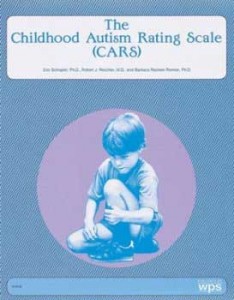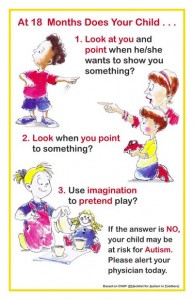There are many assessment tools for detecting autism in children, all of which have their strengths and weaknesses.

One such test is the widely used Childhood Autism Rating Scale (CARS) which was developed in the 1980’s (Schopler et al., 1980). The CARS specifically looks at 15 behavioral based items in which children receive a score ranging from 1 as exhibiting normal behavior to 4 as indicative of autism on assessment of each of these 15 items (Schopler et al., 1980). Children with a total score of less than 30 are not considered autistic while a total score exceeding 36 and scores of 3 or higher on 5 of the behavioral items are considered to be severely autistic (Schopler et al., 1980). Although the CARS is an objective measure for assessing autism, suitable for children younger than 6, and measures severity of autism on a continuum, there are some flaws. Unfortunately, the CARS is relatively old and may not reflect current information on autism. As well, Schopler et al. (1980) had subjects widely dispersed in age from under 6 and over 10, making it difficult to examine young children who might have benefited from early detection. As a result, the CARS assesses children, such as at age 3, who obviously display noticeable deficits and excesses in language and social interaction.

Very early detection of children less than 24 months old was thought to be difficult to find since autism affects a small proportion of children per year (Baron-Cohen, Allen & Gillberg, 1992). Baron-Cohen et al. (1992), however, have developed the Checklist for Autism in Toddlers (CHAT) which can detect autism in children as early as 18 months of age, making it an extremely useful assessment tool. The CHAT is a questionnaire for parents and looks at the behavior of the target child (Baron-Cohen et al., 1992). Parents are asked a variety of questions, some of which pertain to social play, joint attention, pointing to ask for something to indicate interest, and motor development (Baron-Cohen et al., 1992). The 3 key elements that indicate a possibility of autism are an absence of: (1) pointing at an object for joint attention; (2) gaze-monitoring or turning to look in the direction that others are looking; and (3) pretend play (Baron-Cohen et al., 1992).
Related posts:
- Understanding Autism and Autism Treatments It was my father who gave me my first gut-level...
- The Occurrence of Autism Autism afflicts approximately 5 children per 10,000. Ritvo et al....
- A General Overview of Autism and ABA Therapy The use of ABA therapy to teach child autism has...
Comments are closed.